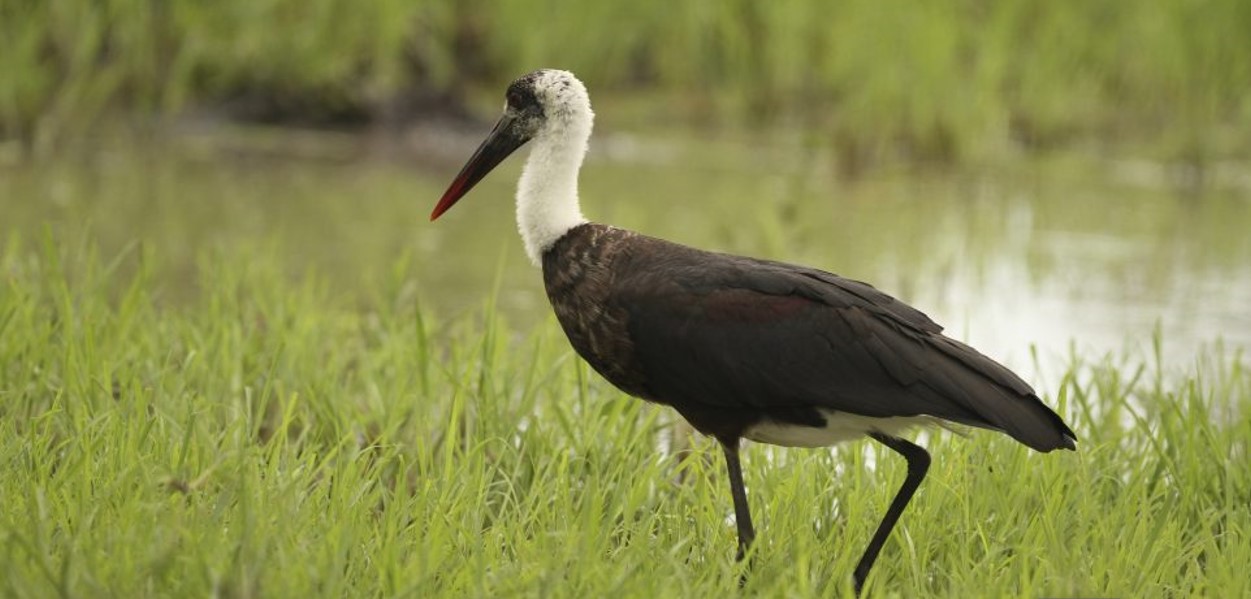
Exploring the Woolly-necked Stork in Uganda
Exploring the Woolly-necked Stork in Uganda: In sub-Saharan Africa, South Asia, and parts of Southeast Asia, the Woolly-necked Stork (Ciconia episcopus) is one of the most recognisable and visually stunning wetlands birds. This species provides an intriguing look into Uganda’s diverse wetland ecosystems and is essential to preserving ecological balance in these habitats.
Taxonomy and Physical Description
The Woolly-necked Stork is a member of the Ciconiidae family. Because of its unique appearance, birdwatchers may easily recognise it
Size: This bird is huge and majestic, measuring about 90 to 100 centimetres (about 3 feet) in length.
Plumage: Mostly white, with a black tail and flight feathers for contrast. Its fluffy, wool-like head and neck, which give the bird a “woolly” appearance, are its most distinguishing characteristics.
Facial Features: Its long, slightly curved bill, which is suitable for fishing and probing in mud, and the bare, bluish skin surrounding the face.
Legs: Perfect for wading through shallow waters, legs are long and slender and usually bluish or grey.
Habitat and Distribution of theWoolly-necked Stork when exploring the Woolly-necked Stork in Uganda
In Uganda, the Woolly-necked Stork is predominantly associated with wetland habitats, which include:
Mangroves and Riverine Forests: Along large rivers, lakeshores, and swamp areas.
Lakes and Marshes: Particularly around Lake Victoria, as well as other water bodies like Lake Albert and seasonal floodplains.
Wetlands and Swamps: Including the Mabamba Swamps, Queen Elizabeth National Park wetlands, and the Alokolum wetlands near Gulu.
These habitats provide abundant food sources such as fish, frogs, crabs, and insects. The presence of Woolly-necked Storks often indicates a healthy wetland ecosystem, as they rely heavily on aquatic prey.
Behavior and Ecology/ Exploring the Woolly-necked Stork in Uganda
Feeding: Woolly-necked Storks demonstrate typical wading behaviors, patiently standing or slowly wading through the water in search of prey. They often hunt alone or in small groups and use their sharp bills to spear or probe for food.
Breeding: They nest in tall trees, often amidst dense foliage. Their nests are large platform structures made of sticks and twigs. They are monogamous, and breeding seasons vary depending on the habitat and climate.
Migration: Considered mostly non-migratory within Uganda, but some movements may occur with seasonal flooding or drought conditions.
Vocalizations: They produce deep, resonant calls, especially during the breeding season, which can be heard echoing across wetlands.
Conservation Status/ Exploring the Woolly-necked Stork in Uganda
The IUCN has designated the Woolly-necked Stork as of Least Concern due to its extensive range. Nonetheless, the following are regional dangers to its communities in Uganda:
Wetland degradation occurs when wetlands are drained for logging, urbanisation, and agriculture. Pollution: Bird health is impacted and prey availability is decreased when water bodies are contaminated.
Climate Change: Wetland ecosystems and breeding cycles are impacted by altered rainfall patterns. Governmental organisations and environmental groups are working to protect wetlands and increase public understanding of their ecological significance.
Importance in Ecosystem and Cultural Significance/ Exploring the Woolly-necked Stork in Uganda
The Woolly-necked Stork, a top predator in wetland settings, contributes to ecological balance by regulating fish and invertebrate populations. Their existence functions as a bioindicator of the health of wetlands.
Because they provide resources like fish, water, and fertile soils, wetlands in Uganda are significant to local communities both culturally and economically. The chance to see and take pictures of these amazing birds is also advantageous to ecotourists and birdwatchers, who help local tourism and conservation efforts.
Tips for Birdwatching and Photography when Exploring the Woolly-necked Stork in Uganda
Best Locations:
- Mabamba Swamps (close to Entebbe)-famous for their bird diversity and accessible via boats.
- Queen Elizabeth National Park’s wetlands.
- Lake Victoria shoreline areas.
- The wetlands near Gulu and northern Uganda.
Best Time to Visit: Early mornings and late afternoons are optimal for bird activity.
Equipment: Use binoculars with at least 10x magnification and a camera with a telephoto lens (at least 300mm) for detailed shots.
Behavioral Observations: Look for the bird wading in shallow waters, often with its neck extended forward, and watch for its distinctive hunting behavior.
Challenges and Future Prospects/ Exploring the Woolly-necked Stork in Uganda
In Uganda, habitat loss and environmental changes are the primary issues confronting Woolly-necked Storks. Water levels are impacted by climate variability, which has an effect on feeding and breeding grounds. To guarantee the species’ continuous existence in Uganda, conservation measures like wetland restoration, the legislative protection of important ecosystems, and community involvement are crucial.
To sum up In addition to being a stunning bird, the Woolly-necked Stork represents Uganda’s abundant wetland biodiversity. Observing this bird in its native environment highlights the value of protecting wetlands for future generations and offers clues into the ecosystem’s health. Observing and preserving this magnificent species is extremely valuable to conservationists, wildlife lovers, and birdwatchers alike. For memorable and rewarding birding tours in East Africa, please contact Journeys Uganda.
